 If the book of Revelation is to be dated to the time of Hadrian (specifically to the late 120s or early 130s) how might the “four horsemen of the apocalypse” be understood?
If the book of Revelation is to be dated to the time of Hadrian (specifically to the late 120s or early 130s) how might the “four horsemen of the apocalypse” be understood?
Some commentaries propose that the white horse represents the preaching of the gospel. The difficulty with this interpretation is that the first rider emerges from the same place as the other horsemen who bring calamities to the world. Should we not expect the white horseman also to be a harbinger of death and suffering?
Revelation 6:1 And I saw when the Lamb opened one of the seven seals, and I heard one of the four living creatures saying as with a voice of thunder, Come. 2 And I saw, and behold, a white horse, and he that sat thereon had a bow; and there was given unto him a crown: and he came forth conquering, and to conquer.
Here is how Thomas Witulski interprets the passage as a prelude to the time of Hadrian. The details are from Die vier ,apokalyptischen Reiter‘ Apk 6,1-8.
A white horse
There is a considerable amount of evidence in ancient Greco-Roman literature linking “white horses” not only with military conquest, imperial power and rulership but also with extending the prestige acquired from those conquests to the level of equality with the divine, especially with the chief god of the Greco-Roman pantheon, Zeus/Jupiter.
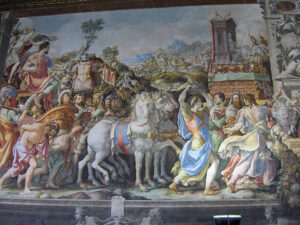
The Roman historian Livy wrote at a time when the Republic of Rome was in crisis and a new age of “emperors” was dawning. Notice the nervous alarm with which he addresses the idea of a past Roman hero using white horses in his Triumphal march through Rome:
The return of Camillus drew greater crowds than had ever been seen on such an occasion in the past, people of all ranks in society pouring through the city gates to meet him; and the official celebration of his Triumph left in its splendour all previous ones in the shade. Riding into Rome in a chariot drawn by white horses he was the cynosure of every eye – and indeed in doing so he was felt to be guilty of a certain anti-republican arrogance, and even of impiety. Might there not be sin, people wondered, in giving a man those dazzling steeds and thus making him equal with Jupiter or the God of the Sun? It was this disquieting thought that rendered the celebration, for all its magnificence, not wholly acceptable. — Livy, V, 23
A later historian, Suetonius, wrote of the advent of Augustus to the world:
On the day Augustus was born, when the conspiracy of Catiline was being discussed in the senate house and Octavius stayed away until late because his wife was in labour, Publius Nigidius, hearing why he was delayed, when informed of the hour of the birth, asserted (as is generally known) that the master of the world was born. When Octavius, who was leading an army through remote regions of Thrace, sought guidance concerning his son at some barbarian rituals in the grove of Father Liber, the same prediction was made by the priests, for so great a flame had leapt up when they poured wine on the altar, that it passed beyond the peak of the temple roof and right up to the sky, a portent which had only previously occurred when Alexander the Great offered sacrifice at that altar. And on the very next night thereafter, he dreamed he saw his son of greater than mortal size with a thunderbolt and sceptre and emblems of Jupiter Best and Greatest and a radiate crown, on a chariot decorated with laurel drawn by twelve horses of astonishing whiteness. — Suetonius, Augustus, 94
By the time of Julius Caesar it was evidently the custom to allow white horses for a conqueror’s Triumph:
For they had voted that sacrifices should be offered for his [Julius Caesar’s] victory during forty days, and had granted him permission to ride, in the triumph already voted him, in a chariot drawn by white horses. — Cassius Dio, Roman History, XLIII, 14,3
Greek and Roman historians described a focus on white horses in Persian royal processions in a similar way:
Then came ten of the sacred horses, known as Nisaean, in magnificent harness, followed by the holy chariot of Zeus drawn by eight white horses, with a charioteer on foot behind him holding the reins – for no mortal man may mount into that chariot’s seat. — Herodotus, Histories, 7, 40
Next after the bulls came horses, a sacrifice for the Sun ; and after them came a chariot sacred to Zeus; it was drawn by white horses with a yoke of gold and wreathed with garlands ; and next, for the Sun, a chariot drawn by white horses and wreathed with garlands like the other. After that came a third chariot with horses covered with purple trappings, and behind it followed men carrying fire on a great altar. – Xenophon, Cyropedia, VIII, 3, 12
Then came the chariot consecrated to Jupiter, drawn by white horses, followed by a horse of extraordinary size, which the Persians called ‘the Sun’s horse’. — Rufus, History of Alexander, 3, 11
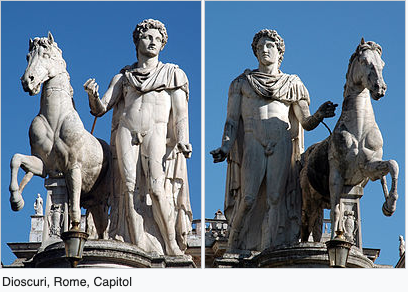 Nor let’s overlook the famed white horses of Castor and Pollux, the sons of Zeus: https://www.theoi.com/Ther/HippoiDioskourioi.html
Nor let’s overlook the famed white horses of Castor and Pollux, the sons of Zeus: https://www.theoi.com/Ther/HippoiDioskourioi.html
Then did the Sons of Zeus, my brethren twain,
Flashing on white steeds come to war with thee. — Euripides, Iphigeneia at Aulis, 1153-1154
We read of other instances where white horses are associated with raw imperial power without any pronounced religious connotation:
. . . in the middle is Rhesos the king, son of Eïoneus. His are the most beautiful horses I have beheld and the most magnificent; they are whiter than snow, they run like the wind . . . Homer, Iliad, X, 435-37
Hard by, his white steeds to his Thracian car
Are tethered : clear they gleam athwart the dark
As gleams the white wing of a river-swan. — Euripides, Rhesus, 616-618[King Turnus] called for his horses and joyfully watched their restive excitement. These horses had been given to Pilumnus by Orithyia herself – a proud possession, for they could outmatch snow in their white brilliance and the winds in their speed. — Virgil, Aeneid, XII, 82-84
A bow
A bow is mentioned but no arrows. The rider is not depicted as making actual use of his weapon so it is possible that the bow was introduced as a symbol.
Given a crown
One would imagine a crown is a reward for victory but here the crown is given before the victories are mentioned.
Conquering and to conquer
Conquering whom? We are not told. But the way it is told there appear to be two stages to the conquering, two campaigns of conquest. (W. discusses the interpretation that Parthian horsemen are being described here but concludes that such an interpretation does not fit the details of what we read in Revelation 6.)
The first rider: the emperor Trajan
Wird – und dafür spricht einiges – die Abfassung der Apk in die Zeit des römischen Kaisers Hadrianus, genauer: in die Zeit zwischen 132 und 135 n.Chr. datiert, somit Kaiser Hadrianus mit dem etwa Apk 13 auftretenden Οηρίον έκ τής θαλάσσης als dem endzeitlichen Gegenspieler des άρνίον Christus identifiziert, so ergibt sich aus der Apk 17,10 aufscheinenden relativen Chronologie der Apk, dass der siebte in der Reihe der acht βασιλείς, d.h. der Nachfolger desjenigen Kaisers, des sechsten, der zur Zeit der Abfassung der Apk amtiert, mit dessen Vorganger Μ. Ulpius Traianus, der von 98 n.Chr. bis 117 n.Chr. regierte, ineins zu setzen ist. Wenn nun der Apokalyptiker – wenn auch fiktiv – die Schau seiner Visionen in die Zeit des sechsten aus der Reihe der Apk 17.10 genannten acht βασιλείς datiert, so folgt daraus, dass, wird in diesen Visionen ein zeitlich vor dem Οηρίον έκ της θαλάσσης amtierender, jedoch bis dato offensichtlich noch nicht als wirkmächtig in Erscheinung getretener römischer Regent geschaut, derselbe nicht mehr mit dem – zumindest im Rahmen der internen relativen Chronologie der Apk – dem Apokalyptiker und seinen Rezipienten bereits bekannten sechsten, sondern mit dem siebten βασιλεύς identifiziert werden muss. Da nun die Auslegung von Apk 6,2 insgesamt prima vista auf eine hinter der Figur des ersten ,apokalyptischen Reiters’ stehende, militärisch sehr erfolgreiche Herrschergestalt zu weisen scheint, legt sich die Annahme mehr als nahe, hinter der Figur des ersten ,apokalyptischen Reiters’ die Gestalt des römischen Kaisers Traianus zu vermuten. Diese Vermutung gilt es nun durch den Aufweis zumindest der Möglichkeit, besser: der Wahrscheinlichkeit des Bezugs der einzelnen in Apk 6,2 vorliegenden Hinweise auf die Person dieses Regenten zu erhärten. W. 134f.
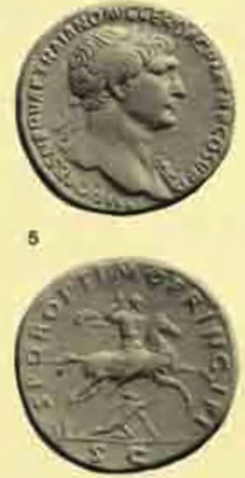
Recall that W. has proposed that the author of Revelation fictitiously set the time of his vision to coincide with the sixth emperor (Rev 17:10), the one who preceded the “beast from the sea” and who was renowned for his military success was Trajan (The original argument is in German: see the side box.)
Trajan was the “conquering emperor”. He was awarded three Triumphs for his conquests. The first in 102 CE, then again in 107 CE, each for campaigns against the Dacians, the third, posthumously, for his supposed victory over the Parthians. For these victories Trajan was granted the titles of Dacicus (102 CE) and Parthicus (115/6 CE). He was the only emperor honoured so highly for successive victories:
| Caesar | Complete titulature at the time of his death | Victory title |
| Augustus | Imperator Caesar Divi filius Augustus. Pontifex maximus. Consul XIII. Imperator XXI. Tribuniciae potestatis XXXVII. Pater Patriae | |
| Tiberius | Tiberius Caesar Divi Augusti filius Augustus. Pontifex maximus. Tribuniciae potestatis XXXIIX. Imperator VIII. Consul V | |
| Caligula | Gaius Caesar Germanicus Augustus. Pontifex maximus. Consul IV. imperator. Tribuniciae potestatis IV. Pater patriae | Germanicus (could be an inherited title) |
| Claudius | Tiberius Claudius Caesar Augustus Germanicus. Pontifex maximus. Tribuniciae potestatis XIV. Consul V. Imperator XVII. Pater patriae | Germanicus |
| Nero | Imperator Nero Claudius Caesar Augustus Germanicus.
Pontifex maximus. Tribuniciae potestatis XIV. Imperator XIII. Consul V. Pater patriae |
Germanicus |
| Galba | Servius Galba Imperator Caesar Augustus | |
| Otho | Imperator Marcus Otho Caesar Augustus | |
| Vitellius | Aulus Vitellius Germanicus Imperator Augustus | |
| Vespasian | Imperator Caesar Vespasianus Augustus. Pontifex maximus. Tribuniciae potestatis X. Imperator XX, Pater patriae. Consul IX | |
| Titus | Imperator Titus Caesar Vespasianus Augustus. Pontifex maximus. Tribuniciae potestatis XI. Imperator XVII. Consul VIII. Pater patriae | |
| Domitian | Imperator Caesar Domitianus Augustus Germanicus. Pontifex maximus. Tribuniciae potestatis XVI. Imperator XXIII. Consul XVII, Pater patriae | Germanicus |
| Nerva | Imperator Nerva Caesar Augustus Germanicus. Pontifex maximus. Tribuniciae potestatis III. Imperator II. Consul IV. Pater patriae | Germanicus |
| Trajan | Imperator Caesar Divi Nervae filius Nena Traianus Optimus Augustus Germanicus. Dacicus. Parthicus. Pontifex maximus. Tribuniciae potestatis XXI. Imperator XIII. Consul VI. Pater patriae | Germanicus (conferred 97 CE – before becoming sole emperor).
Dacicus (conferred 102 A.D.). Parthicus (conferred 115/116 A.D.) |
| Hadrian | Imperator Caesar Traianus Hadrianus Augustus, Pontifex maximus. Tribuniciae potestatis XXII Imperator II Consul III Pater patriae | |
| Antoninus Pius | Imperator Caesar Titus Aelius Hadrianus Antoninus Augustus Pius. Pontifex maximus. Tribuniciae potestatis XIII Consul IV Imperator II Pater patriae |
A white horse
Recall that since Julius Caesar, white horses drew the chariots in Triumphs and were part of the symbolism that exalted the victor to a status comparable to that of Jupiter/Zeus. Trajan, again we recall from recent posts, commenced the construction of the Temple to Zeus in Pergamon and was there worshipped alongside Zeus.
Conquering and to conquer
Of particular significance in the above table, though, is the record of Trajan in a sense being a “twice conqueror”, one who, having conquered, went forth to conquer yet further.
A bow
The orator Dio Chrysostom wrote four discourses on kingship in which he indirectly praised Trajan:
The divine aspects of the perfect ruler and the relationship of such a mortal to the supreme deity and his son loom large in all four orations, although Chrysostom, reciting for a Greek audience, refers to Jupiter and Hercules by their Greek names, as Zeus and Heracles. For example, in quoting Homer on the characteristics of the perfect ruler, one
to whom the son
Of Saturn gives the sceptre, making him
The lawgiver, that he may rule the rest,the rhetor implies that a good ruler could only derive his office and dignity from Zeus, with the express purpose of planning and studying for the welfare of his subjects. He was nurtured by Zeus and was consequently Zeus-like in counsel. Correspondingly, all good rulers were disciples and emulators of the deity in their practice of autocracy, for Zeus alone of the gods has the deserved epithets of ‘Father’ and ‘King’, ‘Protector of Cities and of Suppliants’, ‘God of Refuge and of Hospitality’, ‘Guardian of the Race’ and ‘Lord of Friends and Comrades’. As King of Kings, therefore, Zeus personally protected the good ruler, ensuring that he would live into old age, and vouchsafed his reputation for immortality, were he somehow to be snatched away before the fullness of time.
As proof of divine intervention in Trajan’s advancement to the principate, Dio Chrysostom told of a myth related to him while wandering the western Peloponnesus during his exile. [Or 1:49-84] Between the cities of Heraea and Pisa he chanced upon a country shrine to Heracles. A woman nearby, advanced in years, had the gift of divination, and prophesied that not only would his wanderings soon be ended, but so also would the tribulations of mankind, an allusion to the imminent death of Domitian. She then assured him how he would ‘meet a mighty man, the ruler of very many lands and peoples’, to whom he should relate the story of how Heracles was given the choice of Autocracy or Tyranny as a means of rule, and chose the first, for Tyranny was utterly odious and abominable, and should be ended. Commending his choice, Zeus gave Heracles sovereignty over all mankind, and as Deliverer of the human race and of the earth, he henceforth set out to destroy tyranny and savage and wicked men wherever he found them. Where he found just rulers, however, he protected them and their territory, and, Chrysostom concluded,
even to this day Heracles continues this work, and in him you [sc., Trajan] have a helper and protector of your government as long as it is vouchsafed you to rule.
(Bennett, 145)
Trajan himself presented himself as another Heracles rather than as a higher god. Many of the coins minted during his reign bear the image of Heracles. And as we see in the above quote, the presence of the bow was a distinguishing feature that identified Heracles. As one classicist wrote in The Roman World of Dio Chrysostom:
The last section of the speech, containing the myth of Heracles’ choice, is equally designed to gratify the ruler. Trajan had a personal attachment to Heracles: the hero starts to appear on his coins in the year 100, and about the same time he became the emblem of a new legion, the Second Traiana, probably raised for the first Dacian war. The reason for this attachment is revealed by the legend on the coins, Hercules Caditanus, since the hero had a famous temple at Gades (modern Cadiz), the religious capital of Trajan’s native Baetica. Trajan’s adoption of Heracles as his “helper” also asserted his own proximity to Zeus, the hero’s father and king of the gods; it honored Alexander, who was supposedly descended from Heracles; and generally it symbolized the emperor’s program of arduous toil and selfless devotion to the good of mankind. Dio’s Heracles is more, however, than a symbol of Trajan’s rule, but is also his prototype and avatar. The orator zealously corrects the view that Heracles was a mere king of Argos, or that he traveled the world unaccompanied: rather, he ruled the whole world from sunrise to sunset, visiting every place where there are now temples to him. Dio’s audience knew that Roman emperors claimed the same world-rule; and they could not have failed to think of a temple of Heracles in the far west, in which stood a statue of Alexander once admired by Julius Caesar. Dio’s Heracles was simply educated, not trained by sophists and other such wretches; so too Trajan affected a Roman simplicity, though prepared to listen to a Greek who saw himself as the enemy of sophists. In the same vein Dio explains Heracles’ lion skin and club as symbols of self-denial and his generosity to his friends; he carefully demonstrates that he cannot have traveled alone, but can only have taken cities and overthrown tyrants with an army (59-63). It is evident that the figure with the club and lion skin is Trajan, just as a famous bust shows Commodus in the same dress. (Jones, 117f.)
The satirist and rhetorician Lucian, writing in the generation after Trajan, described Heracles thus:
Surely this is Heracles I see? By his godhead, ’tis no other! The bow, the club, the lion’s-skin, the giant frame; ’tis Heracles complete. — Lucian, Diogenes and Heracles, 11
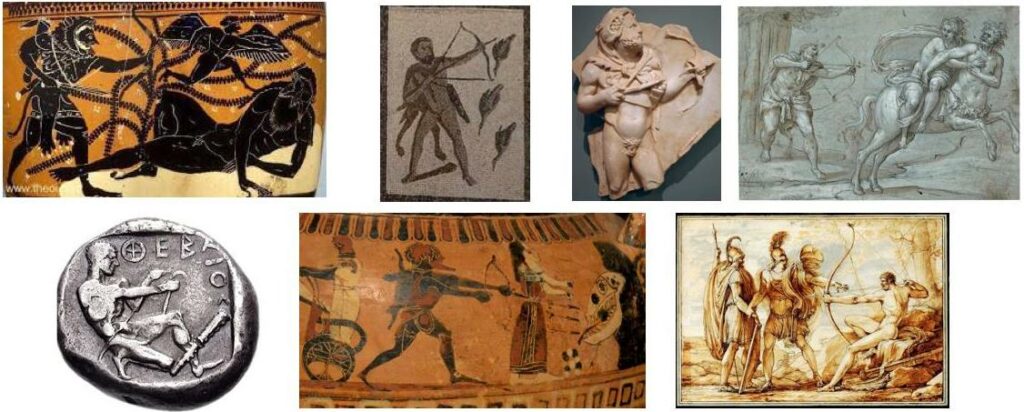
Did the apocalyptist introduce the bow (alone, without arrows) to prompt readers to decode the image in line with the emperor they well knew to be associated with Hercules?
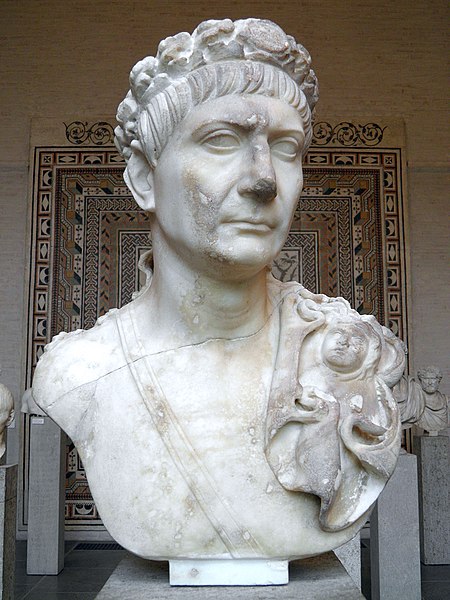
Given a crown
Revelation 6:2 speaks of a crown being given to the rider of the white horse. Trajan was given a crown by the Senate of Rome, not a military crown but one that honoured him as a “father of his country” — the laurel wreathed corona civica. The “civic crown” honoured the wearer as a kindly, saving and merciful figure. Since Trajan was assigned the title “pater patriae” in 99 CE (shortly after his accession) it can be concluded that this was also the occasion when he was crowned with the civic crown.
Witulski sums up the reasons Trajan can reasonably be justified as the figure of the first horseman of the apocalypse:
- the motif of the white horse that was connected with the god Jupiter/Zeus, keeping in mind that Trajan was worshipped alongside the chief of gods in the provincial cult at Pergamon;
- the bow that was associated with the son of Zeus, Hercules/Heracles;
- the civic crown conferred on Trajan by the Senate before his conquests;
- the two-step campaign of conquest that won him the titles of Dacicus and Parthicus.
The above is primarily taken from W’s Die Vier Apocalyptischen Reiter but includes a few other snippets added from additional reading along the way.
 Bennett, Julian. Trajan: Optimus Princeps. Routledge, 2003.
Bennett, Julian. Trajan: Optimus Princeps. Routledge, 2003.
Jones, Christopher P. The Roman World of Dio Chrysostom. Cambridge, Mass: Harvard University Press, 1978.
Witulski, Thomas. Die Vier Apokalyptischen Reiter Apk 6,1-8: Ein Versuch Ihrer Zeitgeschichtlichen (neu-)interpretation. Vandenhoeck & Ruprecht, 2015.
. . .
Cassius, Dio Dio. Roman History, Volume IV: Books 41-45. Harvard University Press, 1916.
Euripides. Euripides with an English Translation by Arthur S. Way. Volume 1. Iphigeneia at Aulis, Rhesus, Hecuba, the Daughters of Troy, Helen. Translated by Arthur S. Way. Loeb Classical Library, 1912.
Herodotus. Herodotus: The Histories. Translated by Aubrey De Sélincourt. Harmondsworth, Middlesex: Penguin Books, 1965.
Homer, and Caroline Alexander. The Iliad: A New Translation by Caroline Alexander. Reprint edition. Ecco, 2016.
Livy. The Early History of Rome: Books I-V of the History of Rome from Its Foundations. Translated by Aubrey De Sélincourt. Penguin, 1960.
Lucian, of Samosata. Selections from Lucian. Indianapolis and Kansas City, Bowen-Merrill, 1896. http://archive.org/details/selectionsfromlu00luci_3.
Rufus, Quintus Curtius. The History of Alexander. Harmondsworth, Middlesex, England ; New York, N.Y., U.S.A: Penguin, 1985.
Suetonius. Lives of the Caesars. Translated by Catharine Edwards. Oxford: OUP Oxford, 2008.
Virgil. The Aeneid. Translated by W. F. Jackson Knight. New York: Penguin Classics, 1956.
Xenophon: Cyropaedia, with an English Translation by Walter Miller. Loeb Classical Library. Heinemann. 2 Vols. Vol. 30, 1916.
If you enjoyed this post, please consider donating to Vridar. Thanks!

Nerva died in 98 CE, though. Otherwise, an excellent post.
Of course. That was either a typo by W. or there is something about the German text that I do not understand. I have requested a copy of the source W. footnoted on that date to see what’s going on. Till then, have removed it from the post.